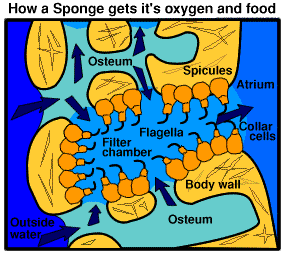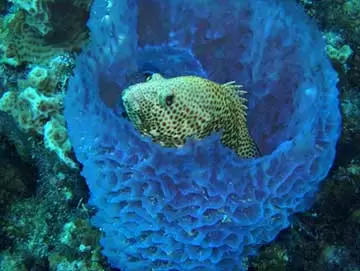The Natural Sea Sponges Company
What does sea sponge eat?
While these ancient creatures may appear stationary and inert, they are, in fact, dynamic filter feeders, actively engaging in the acquisition of nutrients from their watery surroundings. In this comprehensive exploration, we delve into the fascinating realm of sea sponge diet, shedding light on what these remarkable creatures consume and how they go about their culinary pursuits.

The Anatomy of Sea Sponges:
Before delving into the specifics of their diet, it is essential to understand the fundamental anatomy of sea sponges. These fascinating organisms belong to the phylum Porifera, characterized by their porous bodies and lack of true tissues or organs. Instead, sea sponges consist of a complex network of cells supported by a skeleton composed of either calcium carbonate or silica spicules, depending on the species.
The feeding apparatus of sea sponges comprises specialized cells known as choanocytes, which line the interior of their porous bodies. These choanocytes possess distinctive collar-like structures that enable them to capture food particles suspended in the surrounding water. Additionally, sea sponges feature openings called ostia, through which water enters their bodies, and larger openings known as oscula, through which filtered water is expelled.

Feeding Mechanisms:
Sea sponges employ a remarkable feeding strategy known as filter feeding, whereby they actively pump water through their porous bodies to capture suspended particles and extract nutrients. This process begins when water enters the sponge through its numerous ostia, driven by the rhythmic beating of specialized cells called flagella.
As water flows through the sponge's intricate network of channels and chambers, choanocytes trap tiny food particles, including bacteria, phytoplankton, organic detritus, and other microscopic organisms, using their collar-like structures. Once ensnared, these particles are engulfed by the choanocytes through a process known as phagocytosis, wherein they are digested and assimilated to extract essential nutrients.
Once the filtration process is complete, filtered water is expelled from the sponge's body through its oscula, carrying away waste products and facilitating the exchange of gases with the surrounding environment. This continuous flow of water enables sea sponges to efficiently capture food particles while simultaneously maintaining a constant internal environment.
Dietary Preferences and Adaptations:
While the primary diet of sea sponges consists of suspended particles present in the surrounding seawater, their specific dietary preferences may vary depending on factors such as species, habitat, and environmental conditions. For instance, some sea sponges exhibit a preference for particular types of food particles, such as bacteria or phytoplankton, which they actively seek out and capture through their filter-feeding mechanisms.
Furthermore, certain species of sea sponges have evolved specialized adaptations to supplement their diet with larger prey items. For example, carnivorous sponges belonging to the genus Cladorhiza employ sticky filaments or spicules to ensnare small crustaceans and planktonic organisms, which they subsequently consume for nutrition. These carnivorous habits highlight the diverse feeding strategies employed by sea sponges to meet their nutritional requirements in varied marine environments.

Symbiotic Relationships:
In addition to their filter-feeding capabilities, sea sponges often form symbiotic relationships with a diverse array of microorganisms that inhabit their porous tissues. These symbionts play a crucial role in augmenting the nutritional status of the sponge host by facilitating the breakdown of complex organic matter into simpler compounds or providing essential nutrients directly.
For example, symbiotic bacteria residing within the tissues of certain sea sponges contribute to the digestion of cellulose and other complex carbohydrates, enabling the sponge to extract additional nutrients from its diet. Similarly, photosynthetic microorganisms such as algae or cyanobacteria may reside within the cells of some sponges, harnessing sunlight to produce organic compounds through photosynthesis, which are then utilized by the sponge for energy and growth.
Environmental Significance:
The feeding habits of sea sponges have significant implications for the ecology and health of marine ecosystems. As efficient filter feeders, sea sponges play a vital role in maintaining water quality by removing suspended particles, excess nutrients, and organic debris from the surrounding seawater. This filtration process helps to regulate the abundance of planktonic organisms, mitigate algal blooms, and promote overall ecosystem balance.
Furthermore, sea sponges serve as habitat and refuge for a diverse array of marine organisms, including small fish, crustaceans, and invertebrates. Their intricate body structures provide shelter and protection, creating microhabitats that support biodiversity and contribute to the resilience of marine communities.
In conclusion, sea sponges are fascinating organisms with unique feeding mechanisms and dietary preferences that underscore their ecological importance in marine ecosystems. Through their adept filter-feeding capabilities, symbiotic relationships with microorganisms, and diverse dietary adaptations, sea sponges contribute to nutrient cycling, water quality maintenance, and habitat provision in the oceanic realm. By unraveling the mysteries of what sea sponges eat, we gain valuable insights into the intricate web of life that thrives beneath the waves and the delicate balance that sustains it.

